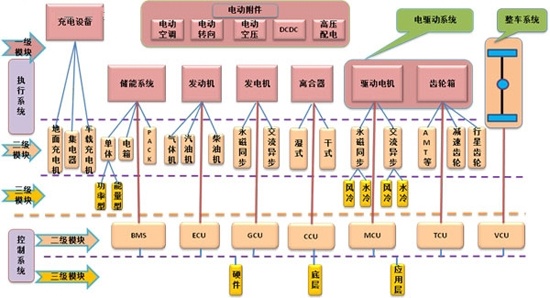In 2014, the domestic production and sales of new energy vehicles exceeded 80,000, and the development trend was gratifying. In order to enable new energy enthusiasts and junior R&D personnel to better understand the core technologies of new energy vehicles, the author combined the experience in the R&D process and analyzed the new energy vehicle classification, module planning, electronic control technology and charging facilities.
1 new energy vehicle classification
In the classification of new energy vehicles, the different classification methods of “weak mixing, strong mixing†and “series, parallel†are confusing for non-industry people. In fact, these names are explanations from different angles and are not contradictory.
1.1 Consumer perspective
The consumer perspective is usually divided according to the degree of mixing, which can be divided into starting and stopping, weak mixing, medium mixing, strong mixing, plugging and pure electric, fuel saving effect and cost increase, as shown in Table 1. The "-" in the table indicates that there is no such function or is weak, and the more "+" the number indicates the better the effect. It can be seen from the table that as the fuel saving effect is improved and the cost is increased.
Table 1 Consumer perspective 
1.2 technical perspective

Figure 1 Technical perspective
The technical perspective is from simple to complex, pure electric, series hybrid, parallel hybrid and hybrid hybrid, as shown in Figure 1. P0 represents the BSG (Belt starter generator) system, P1 represents the ISG (Integrated starter generator) system, the motor is between the engine and the clutch, and the motor in P2 is in the clutch and Between the transmission inputs, P3 indicates that the motor is at the transmission output or is disposed on the rear axle, and P03 indicates a combination of P0 and P3. It can be seen from the statistical table that various structures are widely used in passenger or commercial vehicles at home and abroad. Relatively speaking, P2 is popular in Europe, and the planetary row structure is dominant in Japanese and American vehicles, such as P03. The structure is widely used in four-wheel drive vehicles, and the Outlander and Peugeot 3008 have been mass-produced. The selection of new energy vehicles should take into account structural complexity, fuel economy and cost increases. For example, the three-planetary dual-mode system jointly developed by GM, Chrysler and BMW, despite the better fuel economy, is complicated and costly. The market performance in the past decade has not been satisfactory.
2 New energy vehicle module planning
Although the classification of new energy vehicles is complex, there are many modules shared among them. Modular methods can be used in the development process to share platforms and improve development speed. In general, the whole new energy vehicle can be divided into three-level module system, as shown in Figure 2. The first-level module mainly refers to the execution system, including charging equipment, electric accessories, energy storage system, engine, generator, clutch, and drive. Motor and gearbox. The secondary module is divided into two parts: the execution system and the control system. The execution part includes the ground charger, the current collector and the vehicle charger of the charging device, the unit of the energy storage system, the electric box and the PACK, the gas part of the engine part, the gasoline engine and Diesel engine, permanent magnet synchronous and AC asynchronous of the generator, dry and wet in the clutch, permanent magnet synchronous and AC asynchronous of the drive motor, stepped automatic transmission (including AMT, AT and DCT, etc.) in the gearbox section, planet Row and reduction gear; the control system of the secondary module includes BMS, ECU, GCU, CCU, MCU, TCU and VCU, respectively representing battery management system, engine electronic control unit, generator controller, clutch control unit, motor controller, Transmission control system and vehicle controller. The three-level module system includes the power type and energy type of the battery unit, the water-cooling and air-cooling forms of the permanent magnet and the asynchronous motor, and the three-level module of the control system mainly includes the hardware, the bottom layer and the application layer software.

Figure 2 Three-level module system
According to the similarity of function and control, some modules of the three-level module system can form pure electric (including extended program), plug-in parallel hybrid and plug-in hybrid hybrid platform architecture, such as pure electric (including extended program) It consists of charging equipment, electric accessories, energy storage system, drive motor and gear box. The platform modules are highly versatile. Using platform and module development methods, they can share core component resources, improve the security and reliability of new energy systems, shorten cycle times, and reduce R&D and procurement costs.
Top Battery,High Quality Top Battery,Top Battery Details, Yangzhou Bright Solar Solutions Co., Ltd.
Yangzhou Bright Solar Solutions Co., Ltd. , https://www.cnbrightsolar.com